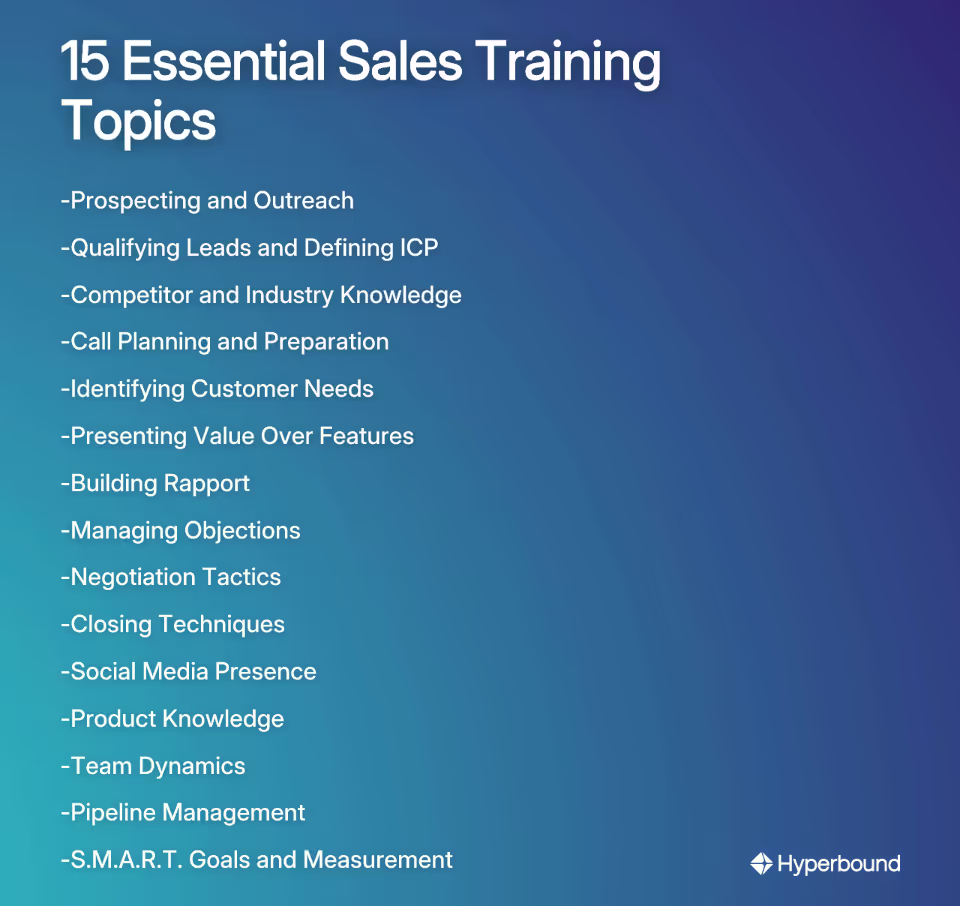%20copy.avif)
You've hired talented sales reps, invested in expensive CRM software, and still, your team isn't hitting targets. Your newly hired salesperson isn't showing "AMAZING results" after their first month, and you're wondering what's missing.
The truth? Even naturally gifted salespeople need structured, comprehensive training to reach their full potential. Many sales leaders struggle with information overload—too many books, YouTube videos, and training programs (many charging "way too much for their worth") without a clear learning path.
This article outlines 15 essential sales training topics that create truly unstoppable sales teams. Whether you're building a program from scratch or enhancing an existing one, these focus areas will accelerate your team's learning curve and drive measurable results.

The Foundation: Why Consistent Sales Training Matters
Before diving into specific topics, let's address why ongoing training is non-negotiable. Organizations that invest in comprehensive sales training can see an 8-14% increase in revenue. With 77% of customers making buying decisions based on service quality, the skills your team develops directly impact your bottom line.
One-time workshops aren't enough—training must be continuous. As one sales leader on Reddit noted, "it took a guy 5-6 months to become confident enough, so later he became number 1 salesperson in the whole company." Great salespeople aren't born overnight.
Part 1: Mastering the Top of the Sales Funnel
1. Prospecting and Outreach
Generating a healthy pipeline is the foundation of sales success, yet it's a significant challenge for many teams. Your Business Development Reps (BDRs) need specific skills to find and engage potential customers effectively.
Training elements should include:
- Research techniques: Top performers spend significantly more time researching prospects before reaching out
- Role-play exercises for cold-calling and email outreach using real-world scenarios
- Networking strategies for generating warm leads instead of relying solely on cold outreach
2. Qualifying Leads and Defining the Ideal Customer Profile (ICP)
Salespeople waste enormous amounts of time chasing bad-fit leads. Effective qualification ensures their efforts focus on prospects who genuinely need your solution and are likely to buy.
Training elements should include:
- Deep understanding of your Ideal Customer Profile (ICP), including target industries, company sizes, and decision-maker personas
- Frameworks for asking targeted questions to uncover needs and determine fit
- Systems for evaluating and prioritizing leads rather than treating every "hot lead" equally
3. Deep Competitor and Industry Knowledge
When prospects compare you to competitors (and they will), your team needs to be prepared. Staying aware of industry trends helps reps position your solution strategically.
Training elements should include:
- Creating and maintaining competitor battle cards that highlight your unique selling points
- Vendor differentiation training that positions your company as the preferred choice
- Processes for sharing competitive intelligence gathered from customer conversations
Part 2: Excelling in the Sales Conversation
4. Call Planning and Preparation
Preparation is a key differentiator between average and top performers. According to LinkedIn research, going into a call unprepared not only wastes the prospect's time but significantly reduces the chance of success.
Training elements should include:
- Developing pre-call checklists that include reviewing the prospect's LinkedIn profile, company news, and previous interactions
- Setting clear objectives for every customer conversation
- Creating standard call planning templates to ensure consistent preparation
5. Identifying Customer Needs (The Discovery Process)
Sales is fundamentally about solving problems, and understanding a buyer's goals and pain points is essential to framing your product as the solution.
Training elements should include:
- Training exercises focused on recognizing both surface and deeper customer pain points
- Active listening techniques where reps must paraphrase what they've heard from customers
- Question frameworks that uncover business challenges and opportunities
6. Presenting Value Over Features
Customers don't buy features; they buy outcomes. Your team needs to connect product capabilities to tangible business value.
Training elements should include:
- Translating technical features into business benefits for different buyer personas
- Crafting compelling value propositions tailored to specific industries
- Regular practice sessions for pitches and presentations with peer feedback
7. Building Rapport and Customer Relationships
As one sales professional on Reddit noted, "Sales is simple, it's relationships and understanding people do business with people they know, like, and trust." This fundamental truth is often overlooked in technical training.
Training elements should include:
- Developing soft skills like communication, empathy, and relationship-building
- Techniques for finding common ground with diverse customers
- Using conversation intelligence tools like Hyperbound to analyze call recordings and coach relationship-building skills

Part 3: Overcoming Hurdles and Closing the Deal
8. Managing Objections and Rejection
Objections are a natural part of the sales process, not a dead end. Many salespeople struggle when faced with customer pushback, but proper training can turn objections into opportunities.
Training elements should include:
- Creating a library of common objections with effective, empathetic responses
- AI-powered role-playing scenarios to practice objection handling in a safe environment
- Frameworks for addressing concerns while maintaining momentum
9. Negotiation Tactics
Poor negotiation skills can erode margins and devalue your product. Your team needs the confidence and tactics to hold firm on value and reach mutually beneficial agreements.
Training elements should include:
- Techniques for framing pricing in terms of value and ROI, not just cost
- Scenario-based training with realistic negotiation situations
- Strategies for handling discount requests without immediately conceding
10. How to Close a Sale
Many reps struggle with directly asking for the sale. As one Reddit user observed, "so many people scared to ask the question like the customer doesn't realize you're trying to sell him something." Closing is a skill that requires creating urgency and assessing customer readiness.
Training elements should include:
- Various closing techniques (assumptive close, summary close, etc.) and when to use them
- Building confidence in asking for the business without appearing desperate
- Recognizing buying signals and timing the close effectively
Part 4: Foundational Skills for Long-Term Success
11. Enhancing Social Media Presence
In modern B2B sales, a professional and active social media presence (especially on LinkedIn) is crucial for research, prospecting, and building a personal brand.
Training elements should include:
- Optimizing professional profiles for maximum impact
- Strategies for sharing relevant content and engaging with prospects online
- Guidelines for maintaining professional digital communication
12. Product Knowledge Training
Reps cannot sell effectively what they do not understand. Deep product knowledge is essential for answering questions confidently and articulating unique selling points.
Training elements should include:
- Not just what the product does, but the problems it solves for different customer segments
- Tools to practice and scale new messaging, ensuring the entire team masters new talk tracks for product launches or competitive updates
- Delivering updates and knowledge refreshers in small, digestible segments
- Hands-on product experience whenever possible
13. Improving Team Dynamics and Collaboration
A toxic, overly competitive sales floor can lead to information hoarding and high turnover. A collaborative environment fosters peer-to-peer learning and collective success.
Training elements should include:
- Understanding individual strengths and weaknesses within the team
- Clarifying roles and responsibilities to prevent conflict
- Creating systems for sharing success stories and knowledge among team members
Part 5: The Manager's Toolkit for Driving Performance
14. Pipeline Management
Effective pipeline management—building and prioritizing leads based on quality and urgency—is highly correlated with rep performance and forecast accuracy.
Training elements should include:
- CRM discipline for tracking deal stages, activities, and next steps
- Regular pipeline review meetings to discuss deal strategy and identify risks
- Metrics and KPIs for measuring pipeline health
15. Setting S.M.A.R.T. Goals and Measuring Effectiveness
Without clear goals and metrics, training is just an activity. To ensure it translates to results, define what success looks like and how you'll measure it.
Training elements should include:
- Setting Specific, Measurable, Achievable, Relevant, and Time-bound goals
- Using the Kirkpatrick Model to measure training effectiveness across four levels:
- Reaction: Did they like the training?
- Learning: Did they acquire the intended knowledge?
- Behavior: Are they applying the skills on the job?
- Results: Did the training impact business KPIs?
Platforms with AI call scoring and coaching can automate the measurement of behavior change and its correlation to results, providing clear data on training ROI.
Building Your Unstoppable Team
An unstoppable sales team isn't born; it's built through commitment to continuous, comprehensive training. The 15 topics covered provide a holistic framework for developing well-rounded, confident, and effective sales professionals.
Remember that sales success takes time. As one experienced sales manager noted on Reddit, "Our training is 10 weeks because of this. Even then some reps really can expect about 3 to 6 months to really feel comfortable." Be patient with your team as they develop.
Don't try to implement everything at once. Start by assessing your team's biggest skill gaps. Pick one or two topics from this list and build a focused training module around them. The journey to an unstoppable team begins with a single, well-executed step.
By investing in these critical sales training topics, you'll create a team that consistently outperforms the competition while building valuable, long-term customer relationships.
Frequently Asked Questions
Why is continuous sales training necessary for an experienced team?
Continuous sales training is necessary even for experienced teams because markets, customer expectations, and sales technologies are constantly evolving. It prevents skilled reps from developing bad habits, introduces them to new strategies for handling modern challenges, and reinforces core skills to maintain a high-performance standard and a competitive edge.
What are the most critical sales training topics to start with?
The most critical topics to start with are foundational, top-of-funnel skills like Prospecting and Outreach, Identifying Customer Needs (Discovery), and Managing Objections. Mastering these areas has the most immediate impact on generating a healthy pipeline and effectively moving deals forward, providing the biggest initial return on your training investment.
How long does it take for sales training to show results?
While minor improvements may appear quickly, it typically takes 3 to 6 months for sales training to yield significant, measurable results. This timeframe allows reps to move beyond initial learning, build confidence, and consistently apply new skills in their daily workflows, ultimately leading to improved KPIs like conversion rates and revenue.
How can I make sales training more engaging for my team?
You can make sales training more engaging by incorporating interactive and practical elements. Move beyond lectures and use role-playing scenarios, peer-to-peer feedback sessions, and competitive gamification. Leveraging technology like Hyperbound’s AI-powered role-play simulators allows reps to practice handling objections and navigating difficult conversations in a safe, repeatable environment.
What is the best way to handle sales objections?
The best way to handle sales objections is to listen carefully to understand the root cause, validate the customer's concern, and reframe the conversation with a clarifying question or value statement. Instead of becoming defensive, treat objections as requests for more information. An effective training program will build a library of common objections and practice empathetic, solution-oriented responses.
How can we measure the effectiveness of our sales training program?
You can measure sales training effectiveness using a multi-level approach like the Kirkpatrick Model. Start by measuring Reaction (did they find it valuable?) and Learning (did they retain the information?). Then, track Behavior (are they applying the new skills in calls?) and, most importantly, Results (did the training impact key business metrics like pipeline growth, deal velocity, or win rates?). AI coaching platforms can help automate this process by scoring real customer calls against your methodology and correlating skill improvements with performance data.

Book a demo with Hyperbound
.png)













